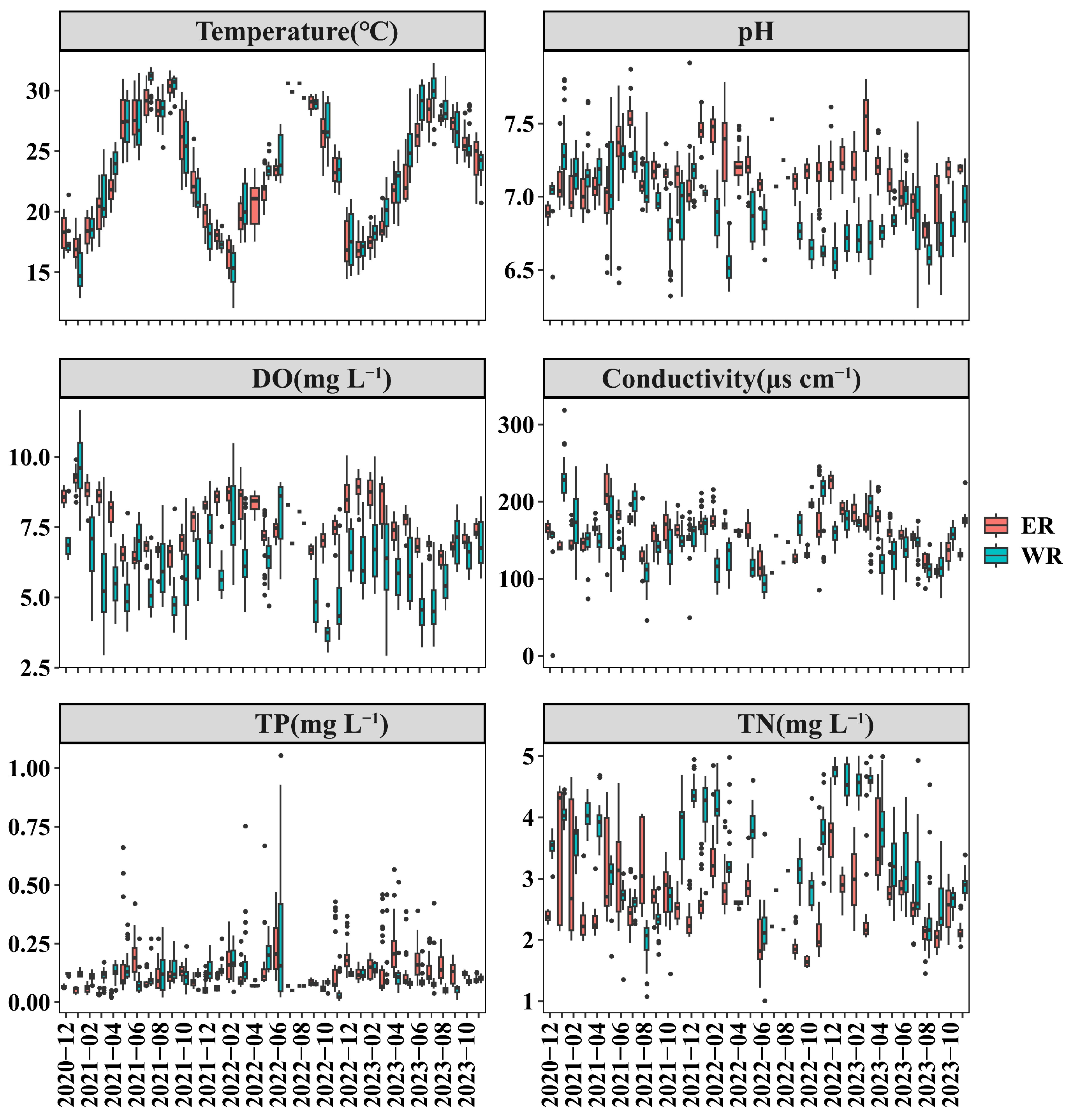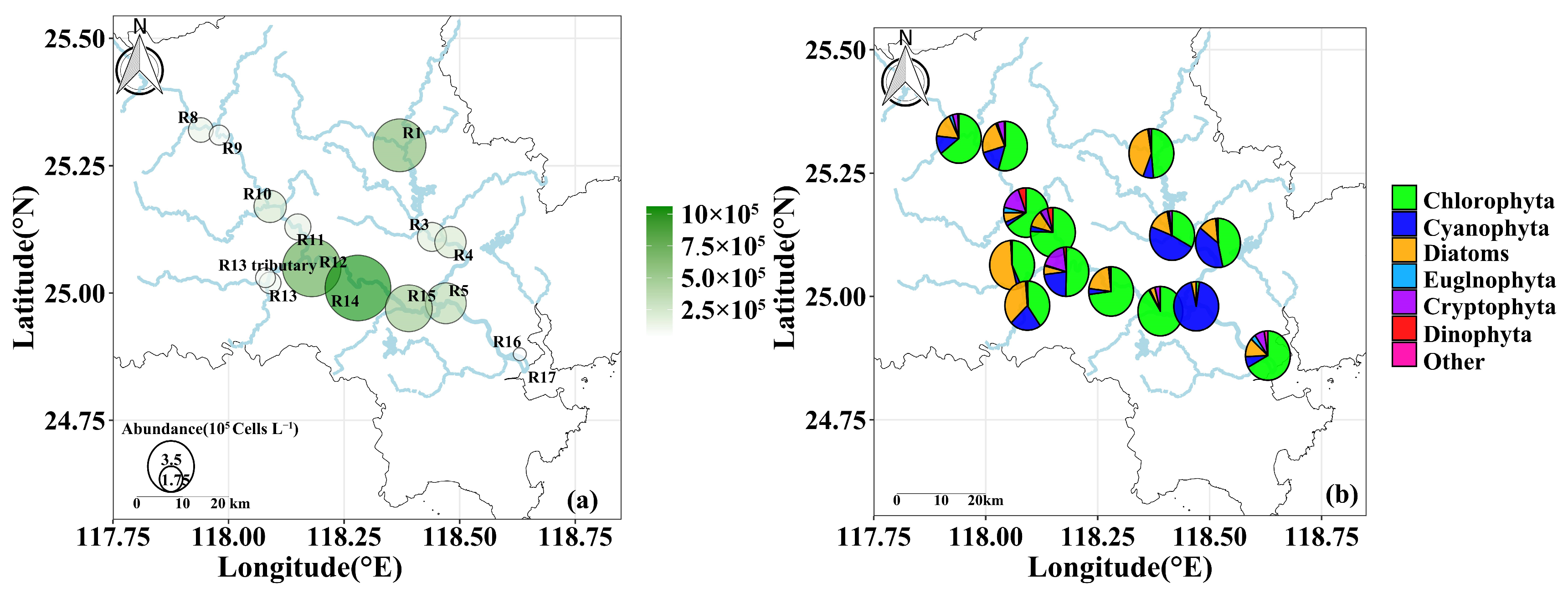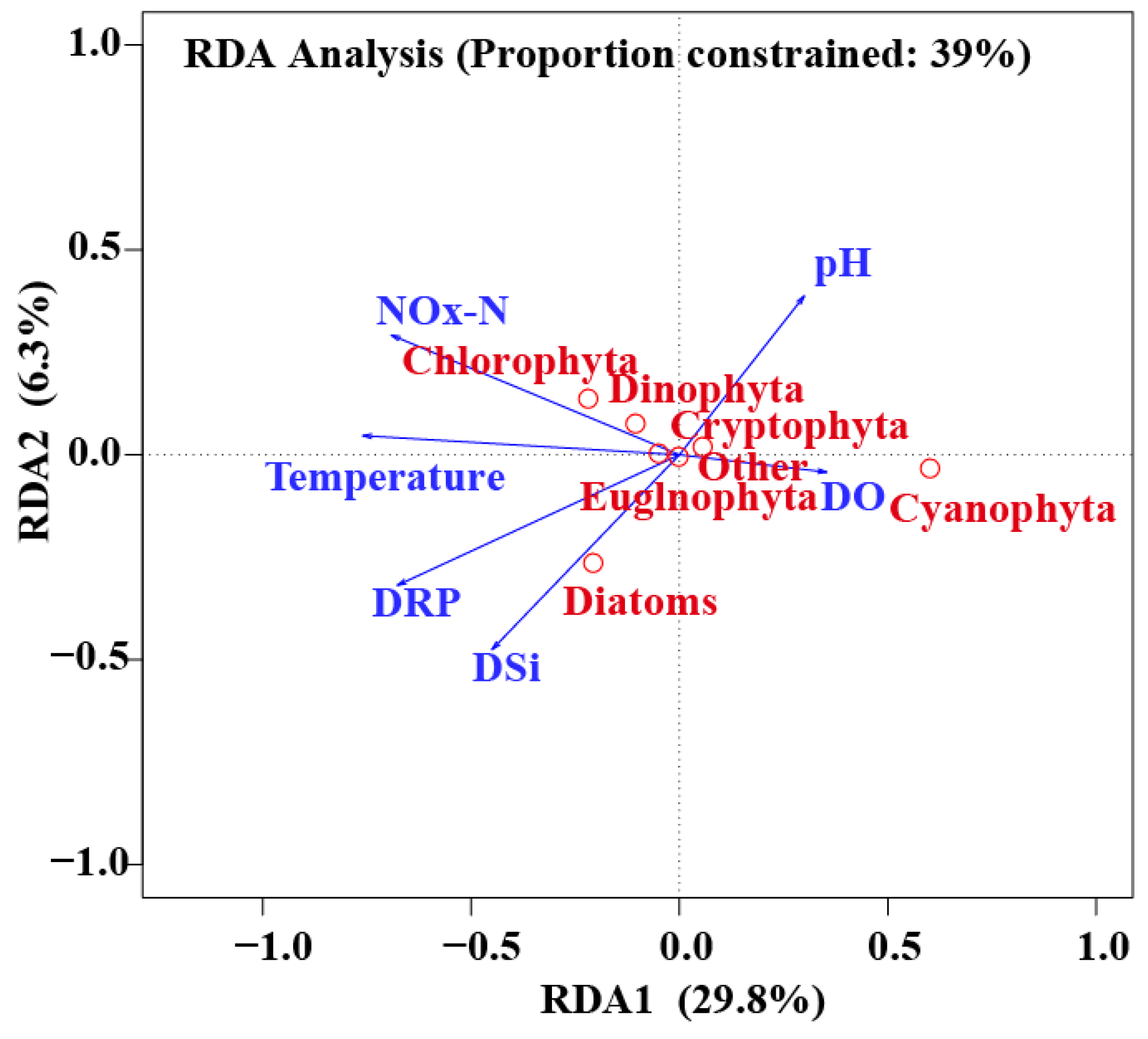Spatial Distribution Patterns of Phytoplankton and Their Relationship with Environmental Factors in the Jinjiang River, China
Abstract
1. Introduction
2. Materials and Methods
2.1. Study Area
2.2. Sample Collection and Analysis
2.3. Data Analysis
3. Results
3.1. Seasonal Variations of Environmental Factors in the Jinjiang River
3.2. Physicochemical Characteristics in the Jinjiang River in the Early Spring of 2023
3.3. Distribution Patterns of Phytoplankton Communities and Their Influencing Factors in the Jinjiang River during the Early Spring of 2023
4. Discussion
5. Conclusions
Author Contributions
Funding
Data Availability Statement
Acknowledgments
Conflicts of Interest
References
- Yang, W.; Zheng, Z.; Zheng, C.; Lu, K.; Ding, D.; Zhu, J. Temporal variations in a phytoplankton community in a subtropical reservoir: An interplay of extrinsic and intrinsic community effects. Sci. Total Environ. 2018, 612, 720–727. [Google Scholar] [CrossRef] [PubMed]
- Umi, W.A.D.; Yusoff, F.M.; Balia Yusof, Z.N.; Ramli, N.M.; Sinev, A.Y.; Toda, T. Composition, Distribution, and Biodiversity of Zooplanktons in Tropical Lentic Ecosystems with Different Environmental Conditions. Arthropoda 2024, 2, 33–54. [Google Scholar] [CrossRef]
- Van Meter, K.; Thompson, S.E.; Basu, N.B. Human impacts on stream hydrology and water quality. In Stream Ecosystems in a Changing Environment; Academic Press: Cambridge, MA, USA, 2016; pp. 441–490. [Google Scholar]
- Zhou, Y.J.; Zhang, Y.Y.; Liang, T.; Wang, L.Q. Shifting of phytoplankton assemblages in a regulated Chinese river basin after streamflow and water quality changes. Sci. Total Environ. 2019, 654, 948–959. [Google Scholar] [CrossRef]
- Le, C.; Zha, Y.; Li, Y.; Sun, D.; Lu, H.; Yin, B. Eutrophication of Lake Waters in China: Cost, Causes, and Control. Environ. Manag. 2010, 45, 662–668. [Google Scholar] [CrossRef]
- Xia, R.; Zhang, Y.; Critto, A.; Wu, J.; Fan, J.; Zheng, Z.; Zhang, Y. The Potential Impacts of Climate Change Factors on Freshwater Eutrophication: Implications for Research and Countermeasures of Water Management in China. Sustainability 2016, 8, 229. [Google Scholar] [CrossRef]
- Akinnawo, S. Eutrophication: Causes, consequences, physical, chemical and biological techniques for mitigation strategies. Environ. Chall. 2023, 12, 100733. [Google Scholar] [CrossRef]
- Lehner, B.; Liermann, C.R.; Revenga, C.; Vörösmarty, C.; Fekete, B.; Crouzet, P.; Döll, P.; Endejan, M.; Frenken, K.; Magome, J.; et al. High-resolution mapping of the world’s reservoirs and dams for sustainable river-flow management. Front. Ecol. Environ. 2011, 9, 494–502. [Google Scholar] [CrossRef]
- Howarth, R.; Swaney, D.; Billen, G.; Garnier, J.; Hong, B.; Humborg, C.; Johnes, P.; Mörth, C.-M.; Marino, R. Nitrogen fluxes from the landscape are controlled by net anthropogenic nitrogen inputs and by climate. Front. Ecol. Environ. 2012, 10, 37–43. [Google Scholar] [CrossRef] [PubMed]
- Beusen, A.; Bouwman, A.; Van Beek, L.; Mogollón, J.; Middelburg, J. Global riverine N and P transport to ocean increased during the 20th century despite increased retention along the aquatic continuum. Biogeosciences 2016, 13, 2441–2451. [Google Scholar] [CrossRef]
- Du, E.; Terrer, C.; Pellegrini, A.; Ahlström, A.; Lissa, C.; Zhao, X.; Xia, N.; Wu, X.; Jackson, B. Global patterns of terrestrial nitrogen and phosphorus limitation. Nat. Geosci. 2020, 13, 221–226. [Google Scholar] [CrossRef]
- Li, L.; Ni, J.; Chang, F.; Yue, Y.; Frolova, N.; Magritsky, D.; Borthwick, A.; Ciais, P.; Wang, Y.; Zheng, C.; et al. Global trends in water and sediment fluxes of the world’s large rivers. Sci. Bull. 2019, 65, 62–69. [Google Scholar] [CrossRef] [PubMed]
- Liu, X.; Beusen, A.; Van Beek, L.; Mogollón, J.; Ran, X.; Bouwman, A. Exploring spatiotemporal changes of the Yangtze River (Changjiang) nitrogen and phosphorus sources, retention and export to the East China Sea and Yellow Sea. Water Res. 2018, 142, 246–255. [Google Scholar] [CrossRef] [PubMed]
- Deng, X.; Xu, Y.; Han, L.; Song, S.; Yang, L.; Li, G.; Wang, Y. Impacts of Urbanization on River Systems in the Taihu Region, China. Water 2015, 7, 1340–1358. [Google Scholar] [CrossRef]
- Yang, H.; Flower, R.J.; Thompson, J.R. Sustaining China’s water resources. Science 2013, 339, 141. [Google Scholar] [CrossRef] [PubMed]
- Peng, X.; Zhang, L.; Li, Y.; Lin, Q.; He, C.; Huang, S.; Wu, Z. The changing characteristics of phytoplankton community and biomass in subtropical shallow lakes: Coupling effects of land use patterns and lake morphology. Water Res. 2021, 200, 117235. [Google Scholar] [CrossRef]
- Bowes, M.J.; Gozzard, E.; Johnson, A.C.; Scarlett, P.M.; Roberts, C.; Read, D.S.; Armstrong, L.K.; Harman, S.A.; Wickham, H.D. Spatial and temporal changes in chlorophyll-a concentrations in the River Thames basin, UK: Are phosphorus concentrations beginning to limit phytoplankton biomass? Sci. Total Environ. 2012, 426, 45–55. [Google Scholar] [CrossRef] [PubMed]
- Scofield, A.E.; Watkins, J.M.; Osantowski, E.; Rudstam, L.G. Deep chlorophyll maxima across a trophic state gradient: A case study in the Laurentian Great Lakes. Limnol. Oceanogr. 2020, 65, 2460–2484. [Google Scholar] [CrossRef] [PubMed]
- Zhong, Y.; Su, Y.; Zhang, D.; She, C.; Chen, N.; Chen, J.; Yang, H.; Balaji-Prasath, B. The spatiotemporal variations in microalgae communities in vertical waters of a subtropical reservoir. J. Environ. Manag. 2022, 317, 115379. [Google Scholar] [CrossRef] [PubMed]
- Jeong, K.S.; Recknagel, F.; Joo, G.J. Prediction and elucidation of population dynamics of the blue-green algae Microcystis aeruginosa and the diatom Stephanodiscus hantzschii in the Nakdong River-Reservoir System (South Korea) by a recurrent artificial neural network. In Ecological Informatics; Springer: Berlin/Heidelberg, Germany, 2006. [Google Scholar]
- Liu, Q.; Jiang, Y.; Huang, X.; Liu, Y.; Guan, M.X.; Tian, Y.L. Hydrological conditions can change the effects of major nutrients and dissolved organic matter on phytoplankton community dynamics in a eutrophic river. J. Hydrol. 2024, 628, 130503. [Google Scholar] [CrossRef]
- Dai, L.L.; Lü, J.C.; Zhou, W.C.; Liu, C.H.; Hu, X.J.; Yuan, G. Phytoplankton’s community structure and its relationships with environmental factors in three rivers with different nutrition levels. Acta Ecol. Sin. 2021, 41, 1242–1250, (In Chinese with English abstract). [Google Scholar]
- Yang, J.; Chan, K.M.; Gong, J. Seasonal variation and the distribution of endocrine-disrupting chemicals in various matrices affected by algae in the eutrophic water environment of the pearl river delta China. Environ. Pollut. 2020, 263, 114462. [Google Scholar] [CrossRef] [PubMed]
- Lofton, M.E.; Leach, T.H.; Beisner, B.E.; Carey, C.C. Relative importance of top-down vs. bottom-up control of lake phytoplankton vertical distributions varies among fluorescence-based spectral groups. Limnol. Oceanogr. 2020; 65, 2485–2501. [Google Scholar]
- Rodríguez-Gálvez, S.; Macías, D.; Prieto, L.; Ruiz, J. Top-down and bottom-up control of phytoplankton in a mid-latitude continental shelf ecosystem. Prog. Oceanogr. 2023, 217, 103083. [Google Scholar] [CrossRef]
- Chen, H.; Teng, Y.; Yue, W.; Song, L. Characterization and source apportionment of water pollution in Jinjiang River, China. Environ. Monit. Assess. 2013, 185, 9639–9650. [Google Scholar] [CrossRef] [PubMed]
- Chen, Z.Y.; Xie, J.J.; Lu, H.S.; Dai, C.J.; Huang, Z.Y.; Yuan, J.J.; Chen, H.Y. A Survey of the Phytoplankton and Evaluation of Water Quality in Jinjiang River. Environ. Monit. China 2006, 5, 82–84, (In Chinese with English abstract). [Google Scholar]
- Wu, Y.; Guo, P.; Su, H.T.; Zhang, Y.X.; Deng, J.; Wang, M.X.; Sun, Y.S.; Li, Y.Q.; Zhang, X.Y. Seasonal and spatial variations in the phytoplankton community and their correlation with environmental factors in the Jinjiang River Estuary in Quanzhou, China. Environ. Monit. Assess. 2022, 194, 44. [Google Scholar] [CrossRef]
- Alahuhta, J.; Kanninen, A.; Hellsten, S.; Vuori, K.M.; Kuoppala, M.; Hämäläinen, H. Environmental and spatial correlates of community composition, richness and status of boreal lake macrophytes. Ecol. Indic. 2023, 32, 172–181. [Google Scholar] [CrossRef]
- Li, D.; Yan, J.; Lu, Z.; Chu, T.; Li, J.; Chu, T. Use of δ13C and δ15N as Indicators to Evaluate the Influence of Sewage on Organic Matter in the Zhangjiang Mangrove–Estuary Ecosystem, Southeastern China. Water 2023, 15, 3660. [Google Scholar] [CrossRef]
- Zhu, Y.; Yang, H.; Xiao, Y.; Hao, Q.; Li, Y.; Liu, J.; Wang, J. Identification of Hydrochemical characteristics, spatial evolution, and driving forces of river water in Jinjiang watershed, China. Water 2023, 16, 45. [Google Scholar] [CrossRef]
- Cheng, B.; Xia, R.; Zhang, Y.; Yang, Z.; Hu, S.; Guo, F.; Ma, S. Characterization and causes analysis for algae blooms in large river system. Sustain. Cities Soc. 2019, 51, 101707. [Google Scholar] [CrossRef]
- Zhang, J.; Ye, D.; Zhu, H.; Hu, S.; Wang, Y.; Tang, J.; Zhou, Z. Characteristics of spring algal blooms under different impounded levels in tributaries of the Three Gorges Reservoir. Acta Hydrobiol. Sin. 2019, 43, 884–891, (In Chinese with English abstract). [Google Scholar]
- Li, Y.; Cao, W.; Su, C.; Hong, H. Nutrient sources and composition of recent algal blooms and eutrophication in the northern Jiulong River, Southeast China. Mar. Pollut. Bull. 2011, 63, 249–254. [Google Scholar] [CrossRef]
- HJ 1216-2021; National Environmental Standards of the People’s Republic of China, specifically the “Determination of Phytoplankton in Water-Microscopic Counting Method with 0.1 mL Counting Chamber”. Ministry of Ecology and Environment of the People’s Republic of China: Beijing, China, 2021.
- Core, T.R. A language and environment for statistical computing, R foundation for statistical computing 2022, Vienna, Austria.
- Xia, R.; Wang, G.; Zhang, Y.; Yang, P.; Yang, Z.; Ding, S.; Jia, X.; Yang, C.; Liu, C.; Ma, S.; et al. River algal blooms are well predicted by antecedent environmental conditions. Water Res. 2020, 185, 116221. [Google Scholar] [CrossRef]
- Yang, J.; Lv, H.; Isabwe, A.; Liu, L.; Yu, X.; Chen, H.; Yang, J. Disturbance-induced phytoplankton regime shifts and recovery of cyanobacteria dominance in two subtropical reservoirs. Water Res. 2017, 120, 52–63. [Google Scholar] [CrossRef]
- Hou, Y.; Li, X.; Bai, L.; Bai, Y.J.; Zhang, S.R.; Wang, S.R.; Zheng, L.; Ding, A.Z. Characteristics of phytoplankton community structure in rivers recharged by different water sources and its relationship with environmental factors. Environ. Sci. 2022, 43, 5616–5626. [Google Scholar]
- Fang, F.; Gao, Y.; Gan, L.; He, X.Y.; Yang, L.Y. Effects of different initial pH and irradiance levels on cyanobacterial colonies from Lake Taihu, China. J. Appl. Phycol. 2018, 30, 1777–1793. [Google Scholar] [CrossRef]
- Qin, B.; Zhou, J.; Elser, J.J.; Gardner, W.S.; Deng, J.; Brookes, J.D. Water depth underpins the relative roles and fates of nitrogen and phosphorus in lakes. Environ. Sci. Technol. 2020, 54, 3191–3198. [Google Scholar] [CrossRef] [PubMed]
- Jensen, J.P.; Jeppesen, E.; Olrik, K.; Kristensen, P. Impact of nutrients and physical factors on the shift from cyanobacterial to chlorophyte dominance in shallow Danish lakes. Can. J. Fish. Aquat. Sci. 1994, 51, 1692–1699. [Google Scholar] [CrossRef]
- Bai, H.F.; Wang, Y.R.; Song, J.X.; Huang, P.; Xu, W.J.; Yin, X.W.; Liu, G.; Li, H.J. Spatio-temporal characteristics and influencing factors of phytoplankton community structure in the Shaanxi Section of Weihe River, China. Acta Sci. Circumstantiae 2021, 41, 3290–3301, (In Chinese with English abstract). [Google Scholar]
- Chen, L.D.; Zhan, J.P.; Wang, Q. Community structure of phytoplankton and their indicative effect on water quality of Pearl River. South China Fish. Sci. 2023, 19, 1–10, (In Chinese with English abstract). [Google Scholar]





Disclaimer/Publisher’s Note: The statements, opinions and data contained in all publications are solely those of the individual author(s) and contributor(s) and not of MDPI and/or the editor(s). MDPI and/or the editor(s) disclaim responsibility for any injury to people or property resulting from any ideas, methods, instructions or products referred to in the content. |
© 2024 by the authors. Licensee MDPI, Basel, Switzerland. This article is an open access article distributed under the terms and conditions of the Creative Commons Attribution (CC BY) license (https://creativecommons.org/licenses/by/4.0/).
Share and Cite
Zhong, Y.; Cai, M.; Cui, J.; Chen, X.; Wang, S.; Chen, Z.; Zhang, S. Spatial Distribution Patterns of Phytoplankton and Their Relationship with Environmental Factors in the Jinjiang River, China. Water 2024, 16, 1497. https://doi.org/10.3390/w16111497
Zhong Y, Cai M, Cui J, Chen X, Wang S, Chen Z, Zhang S. Spatial Distribution Patterns of Phytoplankton and Their Relationship with Environmental Factors in the Jinjiang River, China. Water. 2024; 16(11):1497. https://doi.org/10.3390/w16111497
Chicago/Turabian StyleZhong, Yanping, Mingjiang Cai, Jin Cui, Xinping Chen, Shuhua Wang, Zhenguo Chen, and Shanshan Zhang. 2024. "Spatial Distribution Patterns of Phytoplankton and Their Relationship with Environmental Factors in the Jinjiang River, China" Water 16, no. 11: 1497. https://doi.org/10.3390/w16111497
APA StyleZhong, Y., Cai, M., Cui, J., Chen, X., Wang, S., Chen, Z., & Zhang, S. (2024). Spatial Distribution Patterns of Phytoplankton and Their Relationship with Environmental Factors in the Jinjiang River, China. Water, 16(11), 1497. https://doi.org/10.3390/w16111497




